|
|
| |
|
|
|
|
| |
Why Europeans Care |
|
|
|
| |
|
|
|
|
| |
How Dare They Do This |
|
Big
Tree Representation |
|
| |
Tree Heritage in Europe |
|
Forest Activism
in North America & Australia |
|
| |
|
|
|
|
| |
|
|
| |
|
|
|
|
| |
European Tree Heritage & Activism
In every European country, ancient trees are celebrated and protected as a combined cultural – natural heritage. Many thousands of examples exist of named trees with special characters and histories that are widely celebrated. Yet in colonial countries such as Canada, transnational forest corps are exterminating big trees with no regard for their unique and irreplaceable value. The ancient groves in British Columbia (BC) have taken much of human history to evolve and are rare repositories of wild nature. Yet because Canada is infested by the world's largest and most voracious logging industry, forest activists must stand between the chainsaws and the 1,000 year old arboreal matriarchs; between industrial "progress" – as defined by capitalist economics – and the ancient rainforest. |
|

An ancient English oak tree.
"Veteran Trees of Great Britain" |
|
| |
|
|
 |
|
| |

Ancient olive tree, 2007.
Puglia, Italy
In the English language, many words exist to describe ancient trees, including: big trees, mighty trees, patriarch trees, veteran trees, mammoth trees, sentinel trees, landmark trees, temple trees, venerable trees, heritage trees, historical trees, monumental trees, monarch trees and champion trees. Better yet in other languages is the German "Naturdenkmaeler," the Dutch "Natuurmonument," and the Swedish "Naturminne" to impart a conservation ethic to trees as cultural heritage, such as the treasured German Ivenacker Oaks tributed on a postage stamp (right).
In the 19th century Fritz Reuter dedicated a poem to an Ivenacker oak: "I know an oak tree who stands near the sea, the north wind roars through his gnarly branches; proudly he stretches the mighty crest upwards, like it has done for a thousand years." Aloys Bernatzky, a contemporary author, writes: "From the tree, we learn to see our lives as part of growth and decaying. It is an image and symbol of peace on earth." (Vom Baum lernen wir, unser Leben als Teil des Werdens und Vergehens zu sehen. Er ist Abbild und Sinnbild des Friedens auf Erden). |
|
In Italy a conservation initiative was taken in 2004 to make the historic value of trees more widely known, including protection and exploitation issues. An international conference was organized at the University of Torino:
The Trees of History. In Mediterranean countries, olive trees can live up to 2,000 years and are an integral part of cultural heritage. Strict new laws have been passed in Italy to punish thieves who uproot trees from ancient olive groves in southern Italy to supply a lucrative black market in gnarled old trees as ornaments. Olive trees such as those found in Pugia can fetch thousands of euros (left).
Postage stamp: "Naturdenkmaeler."
Ivenack Oak Society |
|
| |
|
|
 |
|
| |

A Wildlife Tree.
Veteran Trees (Ancient Tree Forum) |
|
Today many European countries are taking part in a movement to recognize and honour the ecological value of big trees as the oldest living beings in the natural landscape. A widespread belief is that of UK's Ancient Tree Forum: "The conservation and protection of ancient trees is the biggest obligation to European biodiversity."
In Britain during the last 50 years, 45 percent of the semi natural woodland has been cleared or converted into plantations, leaving a dearth of "wildlife trees" (left). A management guidebook has been published by the Ancient Tree Forum and tree heritage is being recorded for a national database: "All veteran trees are of historic interest; each is a survivor from the past, a relic of a former landscape"
Veteran Trees. |
|
| |
|
|
 |
|
| |
|
|
Henry William Burgess (far left) was landscape painter to William IV of England. In 1827 he published 54 lithographs of big trees in a book entitled "Eidodendron" (below). A dedication to the king began with "No Tree in all the Grove but has it's Charms." A number of the trees were portrayed as individuals with royal identities such as the "King Oak of Windsor Forest" (left). The illustrations were reproduced as book plates with the help of C. Hullmandel, one of the earliest practitioners of lithography in England. Burgess emphasized the impressionistic qualities of light in his tree portraits and his work is often compared to that of his well known contempories, the landscape painters Constable and Turner. |
|
| |
|
|
|
|
| |
|
Eidodendron – Views of the General Character and Appearance of
Trees Foreign & Indigenous as Connected with Picturesque Scenery, 1827 |
 |
 |
 |
 |
|
Queen Charlotte's Tree Windsor Forest |
Beech Trees
Knowle Park |
Fallen Tree
Bolton Park |
Old Yew
Anckerwycke |
 |
 |
 |
 |
|
Horse Chestnut Trees
Bishops Walk |
Queen Ann Tree
Windsor Forest |
Old Beech Tree
Oaks Surry |
Old Oak
Aloey Forest |
|
|
| |
|
|
 |
|
| |
About 1680 the Reverend Josiah Pullen, vice
principal of Magdalen Hall at Oxford University from 1656 until his death in 1714, planted an elm tree which came
to be known as "Joe Pullen's Tree." In 1847 the land on which the tree stood was sold and the new owner decided to chop the landmark tree down for timber. A protest letter against this "outrage" was published in the Oxford Journal warning "Oxford is about to lose one of the most familiar, the most cherished, and the most venerable memorials." The writer described "the threatened desecration (less I cannot call it)" and the "obliteration of so time honored, so classical, a feature from the scenery of Oxford" as a "melancholy act of destruction." On 24 February 1847 a woman (recorded as Mrs Wright) began an illustration of the tree (right) when the work on felling the lofty elm had just started. This early instance of art being used to stop ancient tree destruction was successful and the tree was spared. Over the years many tributes and poems were written about the famous elm of Headington in Oxfordshire called "Joe Pullen's Tree."
But c. 1849 a wall was built near the tree, damaging its roots and making it susceptible to windblow and root rot. By 1894 it had become necessary to cut down the beloved 200 year old tree but the stump was carefully preserved until 1909 when vandals set it on fire and destroyed it. |
|

Joe Pullen's Tree, Oxford, 1847.
Illustration by Mrs Wright |
|
| |
|
|
|
|
| |
Times Literary Supplement Tree Logo
by Peter Brookes
The tree of knowledge is
a well known visual icon in
many cultures around the
world. As a secular motif,
an ancient knarled oak tree
is often used to symbolize
the western tradition of
learning and scholarship.
It is regrettable that the TLS
has not adopted a non
wood publishing policy. |
 |
|
|
In Europe, trees have long been preserved for specific social purposes. The yew tree, for example, was regarded as sacred and protected in churchyards while oaks were cultivated as picturesque elements on the private hunting estates of the nobility. Today these trees are carefully preserved as nature monuments. By contrast, in British Columbia, there is no protection from the logging industry for the ancient trees which are a vital part of the cultural heritage of the indigenous peoples. Even the big cedars, the aboriginal "Trees of Life" necessary for totem pole carving are threatened with extermination. |
|
| |
|
|
 |
|
| |
Today in Britain landholders and public agencies are working together to protect outstanding trees and woodland heritage. The British Tree Council seeks protected status for trees of special cultural value such as the Great Lime of Holker Hall (right) in its "Green Monuments Campaign." The venerated tree is about 400 years old and the girth of its huge fluted trunk is 25.9 ft (7.9 m). In 2002 the Tree Council designated the Holker Lime one of 50 great British trees, to commemorate Queen Elizabeth's Golden Jubilee. When English author Bill Bryson called for the protection of Britain's ancient trees and woods in an address in 2005 to the All Party Parliamentary Group on Conservation and Wildlife, he made the important point:
|
Ancient trees and woods are vitally important markers of our
rich cultural heritage. We wouldn't suggest that a new road
should be carved through a cathedral, so why do we still
allow ancient trees and woods to be destroyed? |
|
|

Holker Lime, England.
Photo: Floato |
|
| |
|
|
 |
|
| |
Britain claims to have more ancient trees than any other country in northern Europe. Concerned over the need to educate the public about this nature heritage, in 2007 the Woodland Trust began a contest to search for and identify the oldest trees in its "Ancient Tree Hunt." To launch the campaign, a fashion model and Rupert Bear posed together hugging an ancient tree (left). According to Woodland Trust, 92 percent of Brits say it is as important to preserve ancient trees as it is ancient human architecture.

"Tallest Tree in UK Dughall Mhor."
Scone Palace, Perthshire, Scotland |
|

"Rupert finds an ancient tree."
Ancient Tree Hunt, Woodland Trust
Many British ancient trees exist thanks to their location on private estates, such as the Royal Hunting Forests set up by William the Conqueror in 1066. It is ironic that while the British are celebrating their big tree heritage at home, in former colonies such as British Columbia, they condone the commercial extermination of ancient trees, thereby ruining the aboriginal cultural heritage of First Nations. Already in early colonial history, BC's amazingly tall and straight native Douglas fir (Pseudotsuga menziesii) provided the masts for the Royal Navy during the imperial age of conquest. It was named for David Douglas (1799 – 1834), a Scottish botanist who collected seeds from the native Northwest Coast species in Oregon and sent them home to be planted at Scone Palace in Perthshire. Today one seed has grown to a 65 m tree, the tallest in Britain (left). |
|
| |
|
|
 |
|
| |
The tallest tree ever climbed and confirmed in the UK is the Stronardon Douglas fir (below), near Dunans castle in Argyllshire. Planted in 1848 also from a seed collected by botanist David Douglas in Oregon, it was measured in 2009 at 63.79 m (209 ft) high. The Stronardon fir has been classified as a "Champion Tree" by the Tree Register, a charity that records the notable and ancient trees in Britain and Ireland and whose patron is the Prince of Wales.

Stronardon Douglas fir, Scotland, 2009.
Photo: Lukasz Warzecha |
|

Stronardon Douglas Fir, Scotland, 2009.
Photo: Lukasz Warzecha (Click to enlarge)
The height of the Stronardon fir is compared to the famous Nelson's Column in London (above). The Forestry Commission records another 64 m Douglas fir as one of the tallest in the UK, at Reelig Glen Wood, Moniack in the Highlands. |
|
| |
|
|
|
|
| |
Big trees are especially revered in the Netherlands: Dutch trees have been given names and personalities marking their individual histories. The oldest and rarest trees are between 400 and 450 years old but most are between 100 and 200 years old. Among the oldest Douglas firs in Europe are the 150 year old specimens at the Royal Palace Het Loo in the Dutch province of Gelderland (right). When William III built the palace in 1680, oak trees were planted which today are the oldest oaks in the Netherlands. In about 1870 Douglas firs were planted with seeds sent from the Northwest Coast. In 2007 Jeroen Philippona measured one fir at 49 m, the tallest tree in the Netherlands. Unlike the 900 year old native giants of Cathedral Grove, the Dutch Douglas fir trees at Het Loo are protected as treasures.

Anne Frank Tree restoration, 2008.
Ann Frank Museum, Amsterdam |
|

Douglas firs, Het Loo Palace, Netherlands.
Photo: Jeroen Philippona
One Dutch tree that has been much in the news in is the "Anne Frank Tree" in Amsterdam (left). The chestnut tree had comforted the girl while she hid from Nazis in WWII and she described it in her diary: "From my favorite spot on the floor I look up at the blue sky and the bare chestnut tree. . . As long as this exists . . . and I may live to see it, this sunshine, the cloudless skies – while this lasts I cannot be unhappy." Now diseased, Amsterdam officials had planned to cut down the 150 year old tree on 21 November 2007, but protesters claimed its historic value made it imperative to preserve the chestnut at all costs. A website dedicated to this aim is called "Anne Frank Tree." |
|
| |
|
|
 |
|
| |

Oak of Guillotin, Bretagne, France.
Photo: Yannick Meteau
One of the oldest and biggest trees in France, it is also a religious monument.
From an 1830 description of the tree, Le Vieux Chene D'Allouville: "In the cemetery of Allouville, one can see this oak, one of the wonders of France. At its base it is 15.24 meters in circumference and at the height of a human, it is 7.32 meters. This tree is more than 900 years old. Since 1696, the hollow base of the tree has been used as a little shrine to the Holy Mary. During the French revolution, some wanted to burn the tree, but the villagers opposed this. The tree is a greater monument than any building, and many generations of people may find a moment to reflect at its chapel and under its foliage." |
|
One of the legendary trees of France is the Oak of Guillotin (left), with a height of 20 m and a girth of 9.65 m. It stands in the Forest of Brocéliande, Bretagnes, near the village of Concoret. The Chapel Oak (below) is the most famous tree of France, located in Allouville – Bellefosse, a small village near Rouen in Normandy.

Chapel Oak of Allouville–Bellefosse.
Old postcard |
|
| |
|
|
 |
|
| |

La cattedrale vegetale, by Giuliano Mauri.
Photo: Aldo Fedele |
|
It is indeed appropriate that in Italy, home of some of the most magnificent historic cathedrals in the world, an attempt was made to create a "Cathedral of Nature" (left) by a contemporary artist. Designed for an international art exhibit (Arte Sella) in the Sella Valley of the northern Italian Province of Trento, the work by Giuliano Mauri is meant to evoke the idea of "Arte Natura" or the symbiosis between art and nature.
"La cattedrale vegetale" is the same size as a real Gothic cathedral and is composed of three naves, each formed by 80 columns of intertwined branches. Presumably, it fulfills one of the founding principles of Arte Sella; "Nature should be defended as the vessel for our memories." Perhaps because there are no longer ancient groves of monumental trees in Italy, art takes the place of nature. Yet no art or science can recreate the endangered biodiversity of the naturally magnificent Cathedral Grove in British Columbia. |
|
| |
|
|
 |
|
| |
Over many centuries Germans have evolved a close relationship with trees. The German forest ("der deutsche Wald") is the landscape most associated with German history and national identity. The Romantic painter Caspar David Friedrich often painted gnarled old oak trees from nature (right). Already in 1813, the German philosopher Ludwig Klages appealed for the protection of Germany's ancient trees. Also the famous German naturalist and explorer Alexander von Humboldt warned: "Be respectful of the tree. It is a singular wonder." Many other writers too, such as Herman Hesse, have described the primordial force of statuesque old trees in the German landscape: "Trees are sanctuaries. Someone, who knows to talk to them, who knows to listen to them, will learn the truth. They don't preach doctrines or formulas, they preach – not concerned about details – the fundamental law of life." |
|

"Landscape with Oak Trees," 1811.
Painting by C. D. Friedrich |
|
| |
|
|
 |
|
| |

"Ivenack Oaks," Mecklenburg Vorpommern.
Photo: Jeroen Pater
The Ivenack oak grove is a remnant of an ancient type of grazed forest with an open park like character that became a hunting estate in the 18th century. The trees are famous in Germany, not only for their exceptional age and size, but also for the legends and myths which describe their history:
"Long ago, there was in Ivenack a Cistercian Nunnery. Seven nuns were said to have broken their vow of faith and as punishment they were transformed into oaks. Not until 1000 years have passed will the first of the nuns be released and then the oak tree will die. A hundred years later, the second nun will be released and this will continue each century until all of the nuns have been released." |
|
In Germany, certain trees were believed to be a medium of prophecy and knowledge: for instance, large old oaks were the dwelling places of woodland spirits. The "Ivenack Oak" grows in the medieval German forest of Ivenack in Mecklenburg Vorpommern (left). With a massive trunk over 15 m, this tree is the largest recorded German oak and in terms of volume the biggest oak in Europe. In 1900, there were 11 living Ivenack oaks, but today only six remain. Until recently, it was believed that these oaks were between 600 and 1200 years old, but new tree ring research indicates an age of 550 to 830 years.
Big Trees as Natural Monuments The Ivenack oaks are preserved and cared for as "nature monuments" by the Ivenack Oak Society. There are many similar societies dedicated to protecting ancient trees and woods in Europe which are often associated with popular nature centres.

"Ivenack Grove."
Mecklenburg Vorpommern |
|
| |
|
|
 |
|
| |

"Ekebyhov Eken," Sweden, 2008.
Photo: Jeroen Pater |
|

Temple at Uppsala and sacred tree.
Wood engraving, 1555
The most famous grove in Northern Europe was at the ancient Heathen Temple at Uppsala. Adjacent to the Temple was a massive evergreen tree with spreading branches on which human sacrifices were hung. A wood engraving of the tree appears in a 1555 text on Scandinavia by Olaus Magnus (above). Ancient trees were also valued for their economic value in constructing war ships; already by 1558 the King of Sweden, Gustav Vasa, had declared that all oak trees were the property of the royal navy and the Swedish State. The Ekebyhov Eken (left), which today grows in a small village southwest of Stockholm, is the second largest oak in Sweden and it is thought to be one of the oldest, from 500 to 600 years in age. |
|
| |
|
|
 |
|
| |
The renowned Rumskalla Oak in Sweden (right), also known as Kvill eken, is located near the village of Vimmerby, hometown of Astrid Lindgren, author of Pippi Langstroem. The gnarled oak has a large hollow trunk of 14.4 m in circumference: the biggest in Europe. With an estimated age of 850 to 1000 years, Rumskalla is one of the few big trees that remain in Sweden. It grows in a traditional open grazed forest, a biological habitat which survived longer in Sweden than on the Continent and is protected today as a cultural landscape. The Rumskalla Oak was described as remarkable already some 230 years ago, in a book by M. Craelius published in 1772: "Foersoek till ett landskaps beskrivning." Inspired by the Rumskalla Oak, in 1949 the Swedish poet Artur Lindqvist wrote: "Male tree, He brooder, fighter, prepared to become old and solitary, God tree and gallow tree, loved by raven, with the leaves midsummer late . . . " |
|

"Rumskalla Oak."
Vimmerby, Sweden |
|
| |
|
|
 |
|
| |
Due to industrial forestry less than four percent of Sweden's old growth forests survive. In 2004 the Swedish government initiated a protection project to identify surviving ancient trees with conservation values and environmental heritage:
Action Plan for Trees. A recent government report describes the importance of ancient oaks to biodiversity: "Among the old trees, the oak is exceptional. No other tree has so many associated species. Almost 1500 species of fungi, lichens, insects and other invertebrates have the oak as their main habitat. Every individual is unique. . . (right). The long life of the oak contributes to the impressive amount of species associated with it. It can live for as long as 1000 years . . . The number of old trees in this age class has declined drastically in Sweden and the rest of Europe, something that has affected many species and put them on the red list of threatened species"
Living Coastal Woodlands. |
|

Coastal woodland oak, Sweden.
Photo: Jens Johannesson |
|
| |
|
|
 |
|
| |

"Drottning Kristinas lind," Groensoeoe, May 2007.
Photo: Karen Wonders |
|
Queen Christina's lime (left) stands in the early 17th century Renaissance style park in a Swedish royal palace built in 1611, Groensoeoe slott. The royal lime tree was planted in 1623 during the visit of of the King's mother and is one of the oldest lime trees to be found in Europe. In 2003 Queen Silvia planted a genetic copy next to it.
One of Sweden's greatest painters is the wildlife artist Bruno Liljefors (1860 – 1939). Liljefors lived during a period when the forests of Sweden were undergoing industrial clearcutting to supply the new global market economy. The vanishing native fauna and flora was disturbing to many of Liljefors' contemporaries such as August Strindberg. Liljefors painted the wild habitats of game animals and birds, such as a grouse hen nesting in an old pine tree (below) and reaffirmed the importance of Nordic nature to Swedish national identity. |
|
| |
|
|
 |
|
| |
|
|
| |
|
|
 |
|
| |
Most forests in Sweden are younger than 100 years and dominated by single species tree plantations. Both the average tree age and age range of large diameter trees has decreased radically due to industrial logging so that trees older than 400 years are very rare. The situation was different in 1892, prior to industrial forestry, when Prince Eugene painted "Skogen," his well known scene of a dense Nordic forest with light filtering through (right). Painted at the medieval estate of Fjaellskaefte, which today is preserved as a nature reserve, the work expressed a deep respect for the cathedral-like deep forest. Nature was a primary artistic motif for the Swedish prince and his contemporaries, including wildlife painter Bruno Liljefors and playright August Strindberg. As founders of the National Romantic movement, they celebrated the native flora and fauna as an important part of Swedish national identity.
Today most old growth forests in Sweden have vanished and the continued "rape and ravishment of the forest, people and animals" by the state owned Sveaskog (below) has become infamous. See shocking photos of clearcutting ("Kalhugge") that document Swedish industrial forest destruction by Sveaskog and other logging corps on the website "Verkligheten i Skogan" (Truth of the Forest).
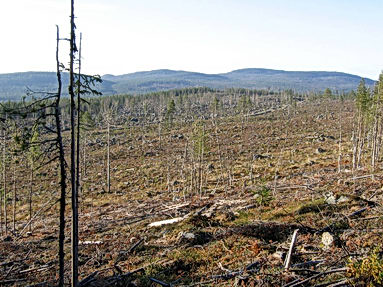
Sveaskog clearcut, Sweden, 2008
Photo: Skydda Skogen |
|
Nordum
Sveaskog's timber is certified by the Forest Stewardship Council (FSC), although the company's logging of intact old growth and high biodiversity forests violate FSC rules. The Swedish Society for Nature Conservation quit FSC Sweden in 2007 because of the council's low standards and lack of transparency. An appeal to end ancient forest destruction has been made: "The big forest companies do not live up to their agreements. Nature preservers . . . plead to the countries who import forest products from Sweden to put pressure on the forest industry and the Swedish government to stop the destruction of the last primeval forests" Skydda Skogen. |
|
| |
|
|
 |
|
| |

Almstriden, Battle of the Elms, Stockholm, 1971
Photo: P. Rodriguez |
|
Among the earliest and most famous cases of European tree activism was the 1971 Almstriden, or Battle for the Elms (left), in the centre of Stockholm. Initiated by Lennart Daléus, a Greenpeace leader, the protest took place the same year that Greenpeace was founded in Vancouver, Canada. To stop the destruction of a group of elm trees for a planned subway station, treesitters kept a vigil in hammocks. When they were attacked by armed state police mounted on horses, the public rallied in support and forced the city to back down. Almstriden was an important symbolic event in the Swedish environmental movement and is seen as the beginning of a grassroots "miljoevaenner" campaign (friends of the environment) to protect nature from urban development. Its success is apparent from the 1995 founding of Ecoparken in Stockholm, a landmark declaration of a "National City Park." |
|
| |
|
|
|
|
| |
Braata Forest is a small 200 hectare forest near the city of Gothenburg in Sweden, formerly owned by a monestry that had preserved the trees. In March 2002 about a quarter of the forest was sold for logging despite its high conservation value. In protest, and to demand the forest be protected, Greenpeace activists locked themselves to trees, only to be forcibly removed by police (right). 20 activists were detained by the large police force but the logging was temporarily stopped because of the protest. On 15 September 2004, when the logging began again, forest activists appeared in the provincial court to challenge the decision. They accused the Swedish state of having over exploited the public forests for over a century with the result that less than five percent of the ancient biologically diverse forests survive. |
|
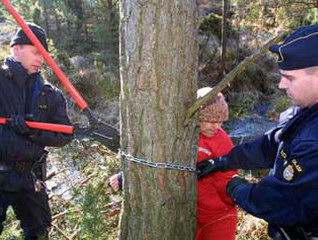
Braata Forest, 9 April 2002
Photo: Greenpeace Sweden |
|
| |
|
|
 |
|
| |
As the Greenpeace map (right) shows, there are no old growth forests in Europe left apart from small remnants in the far boreal north. It is important to remember that in the Nordic countries, an old growth forest is defined either as being from 100 to 150 years in age, or as having not been clearcut in 40 years. In 2004 Greenpeace Sweden staged a protest against the state destruction of old growth forests in the Jokkmokk region of northern Sweden. As a result, 17 forest activists were arrested and later charged in court. In 2005, to protest the destruction of Lappish forests by the Finnish state owned logging company Metsaehallitus, Greenpeace established a Forest Rescue Station in northern Finland at Inari (right), a place where Sami indigenous peoples still practice traditional reindeer herding which is dependent on old growth forests for winter grazing. |
|

Old growth forests in Europe (dark green)
Greenpeace International |
|
| |
|
|
 |
|
| |

Greenpeace activists, Helsinki, 19 April 2005
Photo: Greenpeace Finland |
|
Finland and Sweden are nations whose cultural roots are deeply embedded in the northern forest. Yet during the past century, both countries have developed profitable industries by cutting down the native forests and converting them into tree plantations. Today, despite the green image that they cultivate abroad, Finland and Sweden continue to allow public and private corporations to destroy their native boreal forests by industrial logging. To protest this unsustainable practice, on 19 April 2005, forest activists scaled the Ministry of Forestry building in Helsinki and unfurled a banner saying "Don't Finnish the Sami forests." They also delivered a load of logging waste to the forest minister's office (left). Six forest activists from six European countries were arrested. |
|
| |
|
|
|
|
| |
In 2007 Metsaehallitus began clearcut logging the Kainuu region and in the Kessi wilderness forest in the Saami area of Inari (right). The wood sold to Stora Enso and UPM-Kymmene, Europe's two largest papermakers comes from old growth habitat of threatened species such as the flying squirrel, protected by the Finnish Nature Conservation Act. Despite the importance of protecting this habitat, destructive clearcut logging operations are typically given the go ahead by Pan European Forest Certification, a global organisation that promotes industrial forestry.
Like Canada, the modern industrial economies of Finland and Sweden are significantly built on their forest resources, primarily pulp, paper and wood products. As a result, the forest industry has powerful political connections that facilitate their wrecking of irreplaceable old growth forests and vanishing wilderness habitats. |
|

Old growth logs, Kessi, Finland, 2007
Photo: Greenpeace Finland |
|
| |
|
|
 |
|
| |
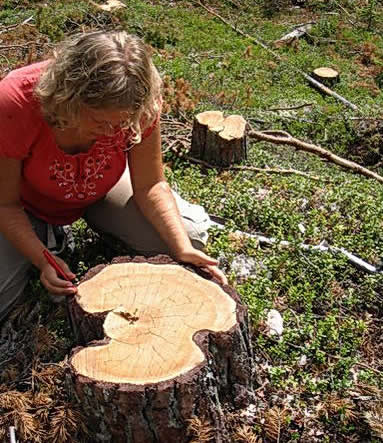
SCA clearcut, Sweden, 2006
Photo: Faeltbiologerna 
Sveaskog clearcut, Sweden, 2008
Photo: Skydda Skogen |
|
A full 95 percent of Sweden's forests are industrial plantations. Only 5 percent are still intact natural forests and a miniscule 1.5 percent are protected from the forest industry. Scientific reports advise that 10 to 20 percent be restored to preserve biological diversity and prevent species extinction. Yet the logging companies are deviously saving low productivity forests with little biodiversity, while clearcutting more profitable forests from the 5 pecent that are hundreds of years old and on which many endangered species are dependent.
Other industrial destroyers of intact natural forests in Sweden are AssiDoman, the world's largest private forest owner, and Svenska Cellulosa Aktiebolaget (SCA). The latter clearcut logged the intact native forest at Ratikbaecken in Vaesternorrlands in 2006 (left), despite its status as a key biotope with high conservation value.
Hundreds of documentary photos of scandalous SCA clearcuts from 24 locations in Sweden taken by a "forest activist" can be seen on the Internet. Evidence of the industrial forest destruction was collected by a youth group of field biologists that was founded in 1947 and is today active in the old growth protection movement. |
|
| |
|
|
 |
|
| |
Swedish and Finnish forest activists are demanding that nature conservation be safeguarded by law in the form of nature reserves and biotope protection areas. A website documenting the destruction of Finnish old growth forests has been launched:
Finnish Forest Lapland. Also in Russia, the threatened boreal forest of Karelia is being illegally logged. Huge amounts of this illegal timber is exported to Finland for processing in pulp and paper mills owned by UPM and Stora Enso (right). In protest, on 22 March 2007 some 40 Greenpeace activists blocked the main entrances to the Botnia pulp mill and the Stora Enso paper mill in the northern Finnish town of Kemi. They also unfurled a banner reading "Stop Ancient Forest Destruction" to expose the world's largest paper company, Stora Enso, for destroying ancient forests to supply paper to leading European magazines. |
|

Illegal logs, Russia, 2004
Photo: GP/ Matti Snellman |
|
| |
|
|
|
|
| |

"Stop Forest Crime," Java Sea, 15 February 2004
Photo: Greenpeace
The Netherlands is one of the biggest importers of tropical wood in the European Union (EU). Activists make a special effort to track down this wood (right) and document its sources of origin, which all too are endangered tropical forests. Pressure is mounting on forest companies and governments, "Partners in Crime," which are responsible for the import of this illegal wood. Huge profits are made, as in the case of the notorious "blood timber" Dutch trader Gus Kouwenhove who was sentenced to eight years in jail for his role in the timber for arms trade with Liberia between 2000 and 2003. This case and others illustrate that the international timber trade is incapable of regulating itself. |
|
The small group of North American and northern European corporations that dominate the forest industry have a global reach making it imperative that protests against ancient forest destruction also occurs in the international arena. Greenpeace International, located in Amsterdam, is especially well positioned for such protests. On 15 February 2004 a protest banner was hung by Greenpeace activists on a cargo of illegal Indonesian timber being transported across the Java Sea (left).

Illegal wood import, Netherlands, 2003
Photo: Greenpeace |
|
| |
|
|
 |
|
| |

Greenpeace action, Rotterdam, 2006
Photo: Greenpeace NL |
|
On 23 November 2007 Greenpeace activists unfurled a huge banner on, and chained themselves to, a cargo ship with palm oil from Riau Indonesia at the Port of Rotterdam (left). Palm oil plantations are destroying the forests and peatlands of Indonesia and pose a serious threat to the global climate. Riau's peatlands store 14.6 billion tonnes of carbon and their destruction has worldwide consequences for global warming. On 13 Octover 2007, 11 Greenpeace activists were arrested for blocking a cargo ship from Canada to stop it unloading newsprint paper made from ancient trees felled in the boreal forest, also one of the world's most important carbon resevoirs. A Greenpeace campaign against clearcutting in Canada, "Kaalkap in Canada," to supply Dutch newspapers was launched: Hollands Glorie. |
|
| |
|
|
|
|
| |
In March 2008 the Dutch group Milieudefensie (Friends of the Earth) released a report on the use of illegal timber in EU financed projects: Building on Forest Destruction. Timber from places like Cameroon has been found in Dutch trading yards (right). The EU is currently drafting a resolution to ban the importation of illegal timber and ensure that companies and consumers do not fuel crimes against humanity and the environment; Forest Law Enforcement, Governance and Trade. EU member governments must ensure a full and transparent chain of custody back to source for all imported timber products. Furthermore, to protect the Earth's remaining ancient forests, governments across the globe must urgently establish moratoria on ancient timber until proper conservation plans based on a global network of protected forest areas have been worked out. More scrutiny is required of worldwide agencies such as FSC which have been infiltrated by big business. |
|

Illegal timber in Holland, 2008
Photo: Milieudefensie |
|
| |
|
|
 |
|
| |

Save Our Trees Protest, Grenoble, 2004
Photo: Jerome Hutin
Some ten tree platforms were built in the Parc Paul Mistral elms with living and cooking spaces and some platforms were linked by hanging bridges (right). People in Grenoble showed their support for the arboreal village by bringing supplies of food and drink which included boiled beef, fondue, foie de gras, cakes, cheeses, tea, fruit juices, wine and bottles of French champagne. The protest campaign collected 15,000 signatures calling for a referendum. |
|
Activists in Grenoble, France, founded a treesit in Parc Paul Mistral in 2004 to protest against the planned destruction by the city of more than 300 trees to make way for a giant football stadium. The trees included a group of 200 year old elms that had been planted in honour of dead people. 1000s of "eco citizens" demonstrated on the street to protest their destruction (left).

Treesit, Parc Paul Mistral, 2004
Photo: Jerome Hutin |
|
| |
|
|
 |
|
| |
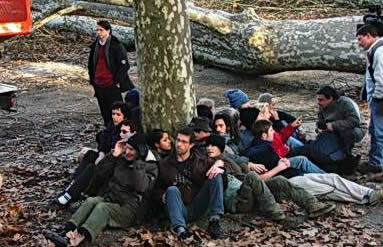
Tree activists, Grenoble, 2004.
Photo: Jerome Hutin |
|
In 2004 hundreds French National Police were sent to the Parc Paul Mistral to forcibly remove a group of tree activists (left). "Le 02 Fvrier 2004, dans l'apers midi, l'abbateur assassin d'Arbres de la Metro est arrive pour tuer, assassiner la superbe alle des Platanes remarquables du Parc Paul Mistral!" Les Arbres Vénérables. In English: "On 2 February 2004, in the afternoon, the Logger Killer of trees of the Metro arrived to kill, to destroy, to murder the wonderful alley of Remarkable Plane Trees of the Parc Paul Mistral of Grenoble, France."
This police crackdown was followed by a second on 12 February 2004 when the "eco citizens" were again forcibly removed and the platforms they had erected in the trees to try to save them were demolished. |
|
| |
|
|
|
|
| |
The Bialowieza Forest in Poland is the single oldest mixed lowland forest in Europe and is said to have 21 species of trees that grow larger and higher than anywhere else in the world. Preserved as a royal hunting ground since the 16th century, it escaped the widespread logging that removed the primaeval forest cover of Europe. Even two World Wars and Nazi occupation did not result in the destruction of the Bialowieza Forest, although over the years much of it has been commercially logged. Since 1994, the Bialowieza Forest Campaign has lobbied for greater protection and a moratorium was placed on the harvesting of old growth trees – defined as those over 100 years in age – but logging continues along with protests by forest activists (right).
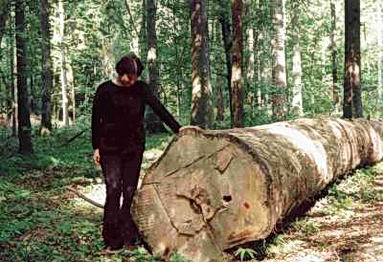
Spruce log, Bialoweza, Poland
Photo: Bialowieza Forest Campaign |
|

Logging protest, Bialoweza, Poland, 2003.
Photo: Bialowieza Forest Campaign
In the Bialowieza Forest, spruce trees aged 200 years or older are being logged under the pretext of battling a bark beetle pest (left). State supported foresters want to harvest the trees and forest activists are fighting to save them. "The European Section of the Society for Conservation Biology urges the EU Commission and national governments to express their desire for protection of the Bialowieza Forest as a unique component of European cultural heritage and an irreplaceable biological treasure." |
|
| |
|
|
|
|
| |
D'Hoppe (La Houppe) is a small village about 40 km south of Ghent in Belgium. Most of the forest around the village is owned by the businessman Marcel Fort, who operates a sand quarry and landfill that has caused ecological damage. To prevent the villagers from protesting, the entrance to the forest was blocked and encircled with barbed wire. The town council and local activists, including pensioners and school children, removed the barbed wire and established a forest camp and treesit decorated with signs and banners (right). Tree climbing seminars were given, protest painting was taught and a documentary film was made. A festive atmosphere accompanied this public manifestation to reclaim the d'Hoppe Forest: "In plaats van een groen paradijs, dreigt La Houppe één grote afvalberg te worden." |
|
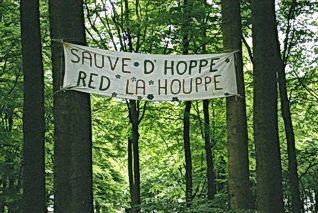
Protest banner, d'Hoppe, Belgium, 2004
Photo: Comit Foert/Fourte |
|
| |
|
|
 |
|
| |
|
|
We Need a Paper Revolution! In Germany there is not much need for tree and forest activism as ancient trees are protected as nature monuments and forests are carefully managed on sustainable principles. Instead German forest activists are working together with the government to reduce the national rate of paper consumption, which is the highest in the world. Public education campaigns include travelling exhibits such as Papierwende (left). One fifth of the German pulp import comes from Canadian forests: "First Nations are having their land robbed while we here in Germany continue to consume and waste more paper" Lydia Bartz, urgewald. |
|
| |
|
|
|
|
| |
WaldAktion BC On 30 June 1993 a demonstration was held in front of the Canadian Embassy in Bonn (right) by AKU, the German Forest activist network. "Tourismusland Canada: bald der Wildnis beraubt?" asks the banner displayed by German forest activists in solidarity with the 1993 Clayoqout Sound protest against clearcut logging. The Canadian ambassador (white jacket) stands beside a timber industry representative who is offering the protesters Douglas fir seedlings as proof of Canada's sustainable forestry practices. Bonn is home to the German Pulp and Paper Association, an industry with 45,000 employees. Canada is the fourth largest pulp supplier to the German paper industry, and ancient red cedars from BC are used for high grade magazine pulp. See a photo narrative on forest destruction in BC. |
|

Protest, Canadian Embassy, Bonn, 1993
Photo: Philipp Kuechler |
|
| |
|
|
 |
|
| |
Kahlschlag in
Kanada On 4 April 2003 another protest was held in Bonn at the Haus der Papierindustrie (right), headquarters of the German Pulp and Paper Association, to protest against its importing of high grade magazine pulp from endangered ancient cedars in BC and to show support for protecting the Great Bear Rainforest. German environmental activist groups Urgewald, RobinWood and AKU staged a symbolic clearcutting, "Kahlschlag in Kanada fuer deutsches Papier," and accused the German paper industry of being accomplice to the robbing of forest lands belonging to the indigenous peoples of the Nuxalk Nation:
Symbolischer Kahlschlag.

"Paper Destroys Forests," Frankfurt, 2004
Photo: Stephan Roehl |
|

Paper Destroys Forests Protest, Frankfurt, 2004
Photo: Stephan Roehl
On 1 February 2004 German environmental groups RobinWood, AKU and Pro Regenwald held a protest at Paperworld in Frankfurt, the biggest international trade fair of its kind (left). One forest activist is seen climbing a flag pole on the far left, having unfurled a huge banner "Paper Destroys Forests" urging visitors to use recycled paper. Other activists dressed as orang utans and bears and tp deliver a poignant message to fair visitors: "the global pulp and paper industry is destroying our forests." |
|
| |
|
|
 |
|
| |
On 31 January 2008 the German forest activist group RobinWood protested in front of the Canadian Embassy in Berlin (right) against the destruction of the ancient Inland Rainforest of BC which is critical habitat for the endangered Mountain Caribou. A banner with the message "Save the Inland Rainforest of Canada" was unfurled and 4,500 protest letters from concerned Germans were delivered to the embassy representative. RobinWood is demanding an immediate stop to the cutting in all stands in the region's rainforest that are over 140 years old.
Further coverageon the Inland Rainforest and endangered Mountain Caribou appears on the Naturschatz website. It exposes the futility of the BC government's protection plan, which does not include the ancient forest habitat on which the caribou depends because of the value of the trees to the logging industry. |
|

BC forest protest, Berlin, 2008
Photo: Stephan Roehl |
|
| |
|
|
 |
|
| |

"Kanada Laden," Viva Touristika Rostock, 2005
Photo: Karen Wonders
Viva Touristika Rostock Selling Canada as the "Wild West" with Mounties and Indians is a lucrative branch of the German tourism industry (left). BC is especially valued for its primeaval coastal forests and their loss is of serious concern. |
|
The British Columbia Forests Society believes that it is time to begin culture in the province, to value trees and associated resources responsibly, as a mainstream part of our everyday lives. The key is to put the responsibility for BC forests into the hands of people and community, rather than Industry and Government, where people and forests can become reconnected in a manner of mutual benefit.

"Kanada-Laden," Viva Touristika Rostock, 2005
Photo: Karen Wonders |
|
| |
|
|
|
|
| |

mmm
mmmm |
|

mmmmmmmmm
mmmmmmmmm
mmmmmm
mmmmmm 
mmm
mmmm |
|
| |
|
|
|
|
| |
|
|
|
|
| |
|
|
 |
|
| |
|
|
| |
©
Credits & Contact |
|
| |
|
|
|
|
|

